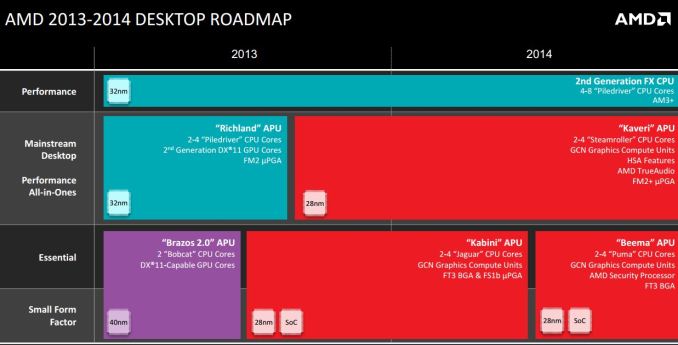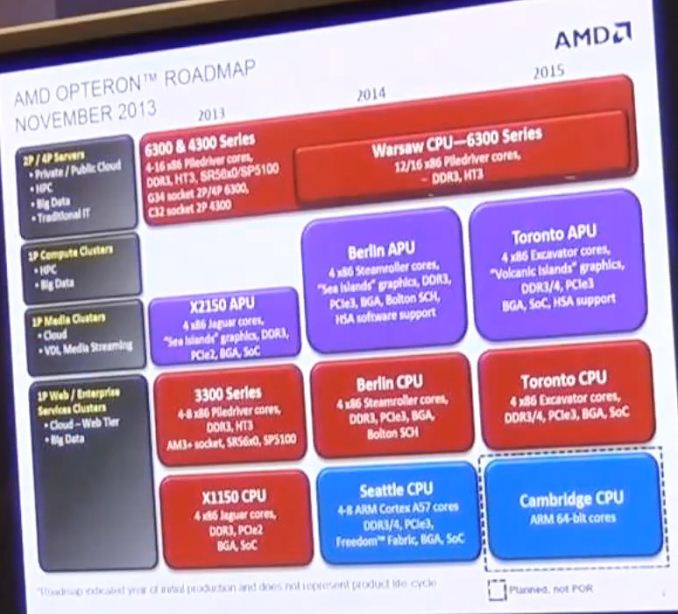AMD Kaveri Review: A8-7600 and A10-7850K Tested
by Ian Cutress & Rahul Garg on January 14, 2014 8:00 AM ESTSocket: FM2+
The new Kaveri processors are built to use the sort-of new FM2+ socket based motherboards. These motherboards fit both FM2+ and FM2 APUs, and thus have been on the market for a good number of months already. However the boards currently on the market may require a BIOS update, and e-tailers shipping motherboards out today may still have the older not-updated revisions in stock, so it is worth confirming that the motherboard you order is updated.
AMD’s generational split on Kaveri is indicative of market pressure and AMD’s history – users like either the processor or the motherboard to be forwards or backwards compatible in terms of compliance. In this case the following table applies:
| Socket Compatibility Chart | ||
| Will Work in FM2 | Will Work in FM2+ | |
| Richland | Yes | Yes |
| Kaveri | No | Yes |
As Kaveri comes with two extra pins that are blocked off with older FM2 motherboards, they are not compatible.
For our testing today, we had sourced the ASRock FM2A88X Extreme6+ and FM2A88X-ITX+ motherboards, both of which will be the focus for review in due course.
Chipset/FCH: A55, A78, A88X
To add some confusion into the mix, AMD is using a mixture of old and new chipsets on FM2+. Kaveri will support the A55, A78 and A88X chipset based motherboards, but not the A75 chipset that was used for Llano/FM1 motherboards. Perhaps more confusing is that while the old Richland APUs will be able to be used on FM2+ with A88X, the older FM2 motherboards will not come with A88X. How about a table to make it clearer:
| Chipset Compatibility Chart | |||
|
Will Work with Llano APUs |
Will Work with Trinity & Richland APUs |
Will Work with Kaveri APUs |
|
| A55 + FM1 | Yes | No | No |
| A55 + FM2 | No | Yes | No |
| A55 + FM2+ | No | Yes | Yes |
| A75 + FM1 | Yes | No | No |
| A75 + FM2 | No | Yes | No |
| A78 + FM2+ | No | Yes | Yes |
| A85X + FM2 | No | Yes | No |
| A88X + FM2+ | No | Yes | Yes |
Though even a table doesn't make the compatibility matrix crystal-clear, it does help to make sense of what users can expect for chipset and sock compatibility. Basically, any A88X motherboard you buy will fit the Kaveri APU. For A78, we are currently under the impression that these will be FM2+ only as well, just do not get confused with older ‘AMD 780L’ Northbridge chipsets that were advertised with A78 in the motherboard name that used the AM3 socket. A55 is almost a free-for-all, with FM1 and FM2 motherboards using it.
As for the differences between the older A85X and A88X chipsets, there are only a few to speak of. Support for PCIe 3.0 is the big one, with any FM2+ and A88X motherboard and Kaveri APU taking full advantage of PCIe 3.0 in all its glory, either as an x16 slot or an x8/x8. A88X still has eight 6 Gbps ports and four USB 3.0 ports native, as well as supporting RAID 0, 1, 5 and 10. The other only upgrade to note is the move to XHCI 1.0.
| Chipset Comparison | |||||
| A55 | A75 | A78 | A85X | A88X | |
| Chipsets |
FM1 FM2 FM2+ |
FM1 FM2 |
FM2+ | FM2 | FM2+ |
| PCIe Generation | 2.0 | 2.0 | 2.0 | 2.0 | 3.0 |
| PCIe Lane Allocation | 1x16 | 1x16 or 2x8 | 1x16 | 1x16 or 2x8 | 1x16 or 2x8 |
| SATA 6/3 Gbps | 0 + 6 | 6 + 0 | 6 + 0 (?) | 8 + 0 | 8 + 0 |
| USB Ports (3/2/1.1) | 0 + 14 + 2 | 4 + 10 + 2 | 4 + 10 + 2 (?) | 4 + 10 + 2 | 4 + 10 + 2 |
| RAID | 0, 1, 10 | 0. 1, 5, 10 | 0. 1, 5, 10 | 0. 1, 5, 10 | 0. 1, 5, 10 |
| TDP | 7.6 W | 7.8 W | 7.8 W ? | 7.8 W | 7.8 W ? |
Unusually for AMD, little information about chipset evolution was provided through the normal channels.
What about FX CPUs, or Server CPUs?
Leaked roadmaps have not been kind to AMD’s FX range. The ‘king’ of the Vishera family of FX CPUs, the quad-module eight-thread FX-9590, looks like it will be the king of the FX line for a little while longer, as shown in this roadmap:
As you might imagine, there is no public comment from AMD about the lack of new FX CPUs with Steamroller cores coming soon.
Depending on which roadmap you look at, AMD’s server offerings are mixed. Some report that During 2014 we will see the launch of “Warsaw” CPUs featuring 12-16 Piledriver cores, and there is no current mention of high-end Steamroller based Opterons at all. The official roadmap from AMD from June shows this, including their ARM server discussion, but a recently leaked roadmap shows that Steamroller will appear in their 1P compute clusters, followed by Excavator in 2015, but Piledriver based 12-16 thread machines will stay at the top of the pile.













380 Comments
View All Comments
geniekid - Tuesday, January 14, 2014 - link
Would've been nice to see a discrete GPU thrown in the mix - especially with all that talk about Dual Graphics.Ryan Smith - Tuesday, January 14, 2014 - link
Dual graphics is not yet up and running (and it would require a different card than the 6750 Ian had on hand).Nenad - Wednesday, January 15, 2014 - link
I wonder if Dual Graphics can work with HSA, although I doubt due to cache coherence if nothing else.While on HSA, I must say that it looks very promising. I do not have experience with AMD specific GPU programming, or with OpenCL, but I do with CUDA (and some AMP) - and ability to avoid CPU/GPU copy would be great advantage in certain cases.
Interesting thing is that AMD now have HW that support HSA, but does not yet have software tools (drivers, compilers...), while NVidia does not have HW, but does have software: in new CUDA, you can use unified memory, even if driver simulate copy for you (but that supposedly means when NVidia deliver HW, your unaltered app from last year will work and use advantage of HSA)
Also, while HSA is great step ahead, I wonder if we will ever see one much more important thing if GPGPU is ever to became mainstream: PREEMPTIVE MULTITASKING. As it is now, still programer/app needs to spend time to figure out how to split work in small chunks for GPU, in order to not take too much time of GPU at once. It increase complexity of GPU code, and rely on good behavior of other GPU apps. Hopefully, next AMD 'unification' after HSA would be 'preemptive multitasking' ;p
tcube - Thursday, January 16, 2014 - link
Preemtion, dynamic context switching is said to come with excavator core/ carizo apu. And they do have the toolset for hsa/hsail, just look it up on amd's site, bolt i think it's called it is a c library.Further more project sumatra will make java execute on the gpu. At first via a opencl wrapper then via hsa and in the end the jvm itself will do it for you via hsa. Oracle is prety commited to this.
kazriko - Thursday, January 30, 2014 - link
I think where multiple GPU and Dual Graphics stuff will really shine is when we start getting more Mantle applications. With that, each GPU in the system can be controlled independently, and the developers could put GPGPU processes that work better with low latency to the CPU on the APU's built in GPU, and processes for graphics rendering that don't need as low of latency to the discrete graphics card.Preemptive would be interesting, but I'm not sure how game-changing it would be once you get into HSA's juggling of tasks back and forth between different processors. Right now, they do have multitasking they could do by having several queues going into the GPU, and you could have several tasks running from each queue across the different CUs on the chip. Not preemptive, but definitely multi-threaded.
MaRao - Thursday, January 16, 2014 - link
Instead AMD should create new chipsets with dual AMU sockets. Two A8-7600 APUs can give tremendous CPU and GPU performance, yet maintaining 90-100W power usage.PatHeist - Thursday, February 13, 2014 - link
Making dual socket boards scale well is tremendously complex. You also need to increase things like the CPU cache by a lot. Not to mention that performance would tend to scale very badly with the additional CPU cores for things like gaming.kzac - Monday, February 16, 2015 - link
Having 2 or more APUs on a logic board would defeat the purpose of having an APU in the first place, which was to eliminate processing being handled by the logic board controller. With dual APU sockets, there would need to be some controller interjected to direct work to the APUs which could create a bottle neck in processing time (clock cycles). This is the very reason for the existence of multi core APUs and CPUs of today.Its my expectation that we will start to observe much more memory being added to the APU at some point, to increase throughput speeds. Essentially think of future APUs becoming a mini computer within, the only limitations currently to this issue are heat extraction and power consumption.
5thaccount - Tuesday, January 21, 2014 - link
I'm not so interested in dual graphics... I am really curious to see how it performs as a standard old-fashioned CPU. You could even bench it with an nVidia card. No one seems to be reviewing it as a processor. All reviews review it as an APU. Funny thing is, several people I work with use these, but they all have discrete graphics.geniekid - Tuesday, January 14, 2014 - link
Nvm. Too early!